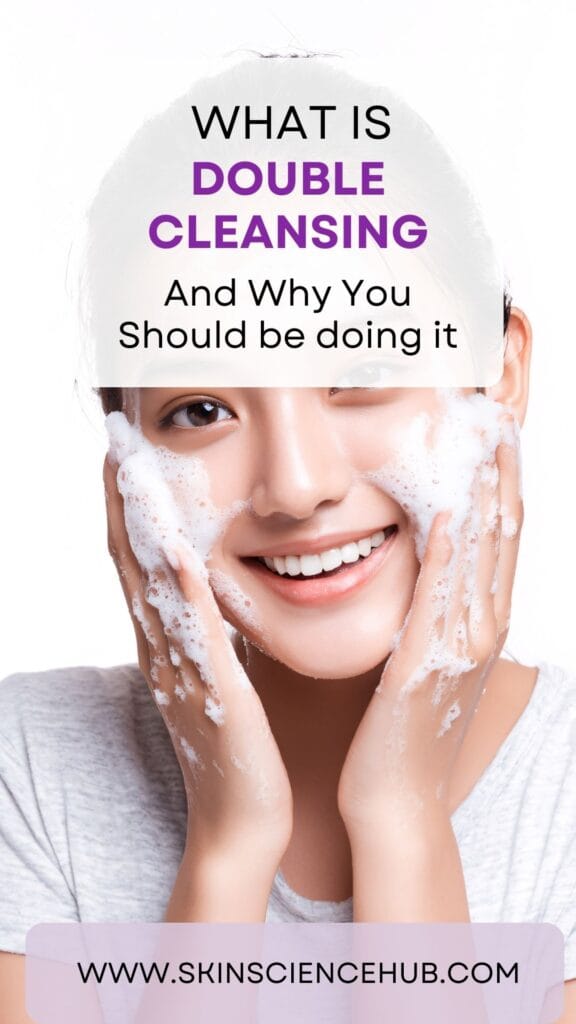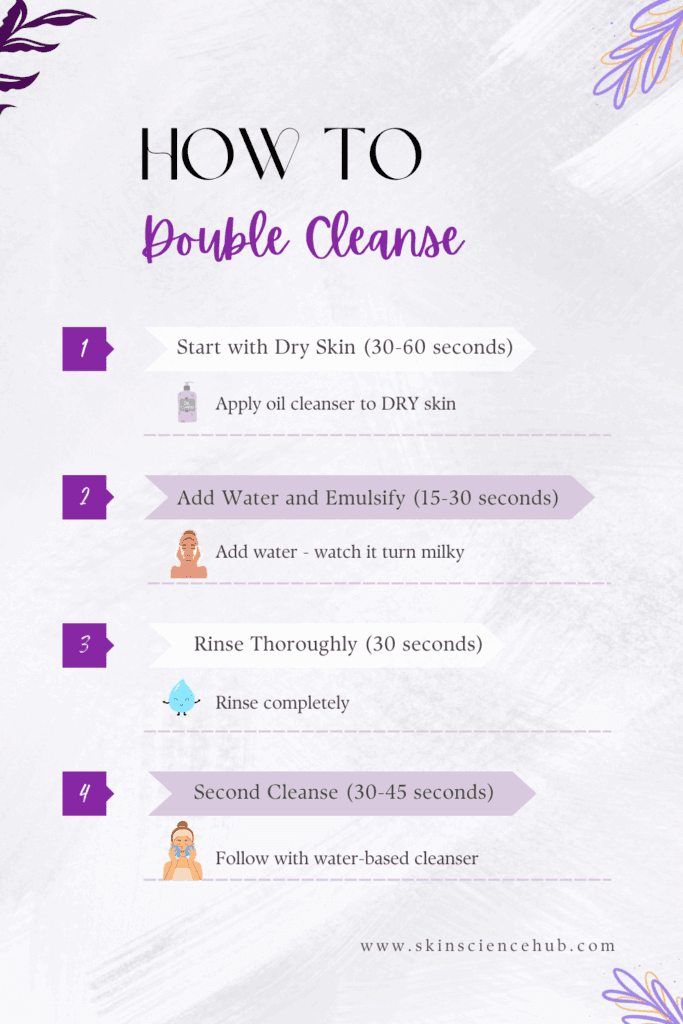What Is Double Cleansing and Do You Actually Need It?
I’m sure you’ve wondered “Do I really need to double cleanse?” You’ve seen everyone talking about it, influencers swearing by it, and skincare brands pushing oil cleansers. But is it actually important, or just another way to sell you more products?
After six years of trying and testing double cleansing, I can tell you this method isn’t K-beauty hype designed to complicate your life. It’s basic chemistry that solves a real problem, but only if you understand exactly when you need it and when you’re just wasting time and money.
What exactly is double cleansing and why does it work when single cleansing fails?

This post contains affiliate links. As an Amazon Associate, I earn from qualifying purchases. Read full disclosure
What Is Double Cleansing? (Complete Beginner’s Guide)
Double cleansing is a two-step face washing method where you first remove oil-based residue with an oil-based cleanser, then follow with a water-based cleanser to address everything else. Think of it like pre-treating a stain before washing clothes, you’re targeting different types of residue with the most effective removal method for each.
The underlying principle is “like dissolves like,” a fundamental chemistry concept that explains why oil-based products excel at removing oil-based substances like makeup and sunscreen, while water-based cleansers handle sweat, water-soluble products, and environmental debris.
Do You Actually Need Double Cleansing?
The answer depends entirely on what you’re asking your cleanser to remove:
You probably benefit from double cleansing if you:
- Wear makeup daily (even tinted moisturizer)
- Use water-resistant sunscreen regularly
- Live in a polluted urban environment
- Feel like your face isn’t truly clean after washing
- Notice your skincare products don’t absorb well
Skip it if you:
- Have very sensitive, compromised skin
- Rarely wear makeup or sunscreen
- you’re happy with your current face washing routine and it leaves your skin clean and comfortable, you might not need the extra step.
- Find the extra step overwhelming
If you wear foundation, concealer, or waterproof mascara regularly, or if you’re diligent about broad-spectrum sunscreen application, you’re dealing with stubborn oil-based residues that single cleansing struggles to address completely.
The Science Behind Why Double Cleansing Works
Your skin accumulates two fundamentally different types of residue throughout the day. Think of your face like a dinner plate after eating spaghetti with marinara sauce. You’ve got oily residue (the olive oil and parmesan) and water-based residue (the tomato sauce and breadcrumbs).
Single cleansers usually handle one type well but struggle with the other. It’s like trying to clean oily cheese off your plate with just water, it mostly slides around rather than actually removing.
When you massage an oil cleanser on your skin, it dissolves oil-based residues through direct chemical attraction. Picture how dish soap works on greasy pans, the soap molecules grab onto grease and lift it away. Adding water activates emulsifiers that turn everything into a milky mixture that rinses cleanly. The second cleanser handles any remaining traces and water-soluble residues.
Oil Cleansing for Oily Skin Makes Sense
This concern stops most people with oily skin, but here’s where chemistry gets counterintuitive. Remember trying to get gum out of your hair as a kid? Your mom probably used peanut butter or ice, not water, because removing sticky substances requires matching the right solvent to the problem.
Oil cleansing works the same way. It functions through dissolution, not by adding more oil to your skin. Think of it like using cooking oil to remove price tag adhesive, the oil dissolves the sticky residue so you can wipe it away cleanly.
The cleansing oils bind with sebum, makeup, and sunscreen through molecular attraction and lift these substances away from your skin surface. Properly formulated cleansing oils contain emulsifying systems that ensure complete removal when you add water. You’re not leaving oil on your skin, you’re using oil as a solvent that gets thoroughly removed.
Many people with oily skin find oil cleansing more effective than harsh foaming cleansers for removing stubborn sebum plugs because oil dissolves oil. Foaming cleansers try to strip away sebum, which can irritate skin and trigger more oil production as your skin tries to replace what was lost.
How Long to Double Cleanse Your Face
Research shows that massage duration matters for effectiveness. Heavy makeup breakdown requires 45-90 seconds of gentle dissolution time, while sunscreen emulsification needs adequate contact time for zinc oxide and titanium dioxide formulas to break down properly.
The goal is giving products adequate working time, typically 30-60 seconds, with gentle pressure. Over-massaging can irritate your skin, while over-cleansing can compromise your skin barrier.
The massage phase also helps lift dead skin cells ready to shed, providing mild exfoliation without harsh scrubbing. This has become my favorite part of the routine, it’s genuinely relaxing and helps me unwind.
How to Double Cleanse: Step-by-Step Method

Step 1: Start with Dry Skin (30-60 seconds) Apply oil cleanser or balm to completely dry skin. Water dilutes the product and reduces its ability to dissolve oil-based residues effectively. Massage gently, giving the chemistry time to work.
Step 2: Add Water and Emulsify (15-30 seconds) Add a few drops of water while continuing to massage. You’ll observe the product transform from clear oil to milky texture as emulsifying agents activate. This indicates oil-based residues are now suspended in a water-soluble mixture.
Step 3: Rinse Thoroughly (30 seconds) Remove everything completely. Any remaining residue can interfere with your second cleanse.
Step 4: Second Cleanse (30-45 seconds) Follow with your regular water-based cleanser to remove any traces and address water-soluble residues.
Total time: 2-3 minutes, less than most people spend removing waterproof mascara with wipes.
Best Double Cleansing Products (Tested and Reviewed)
The key is choosing products appropriate for your individual needs – if you’re unsure about your skin’s specific requirements, learn how to determine your skin type first
First Cleanse Options
Oil Cleansers:



